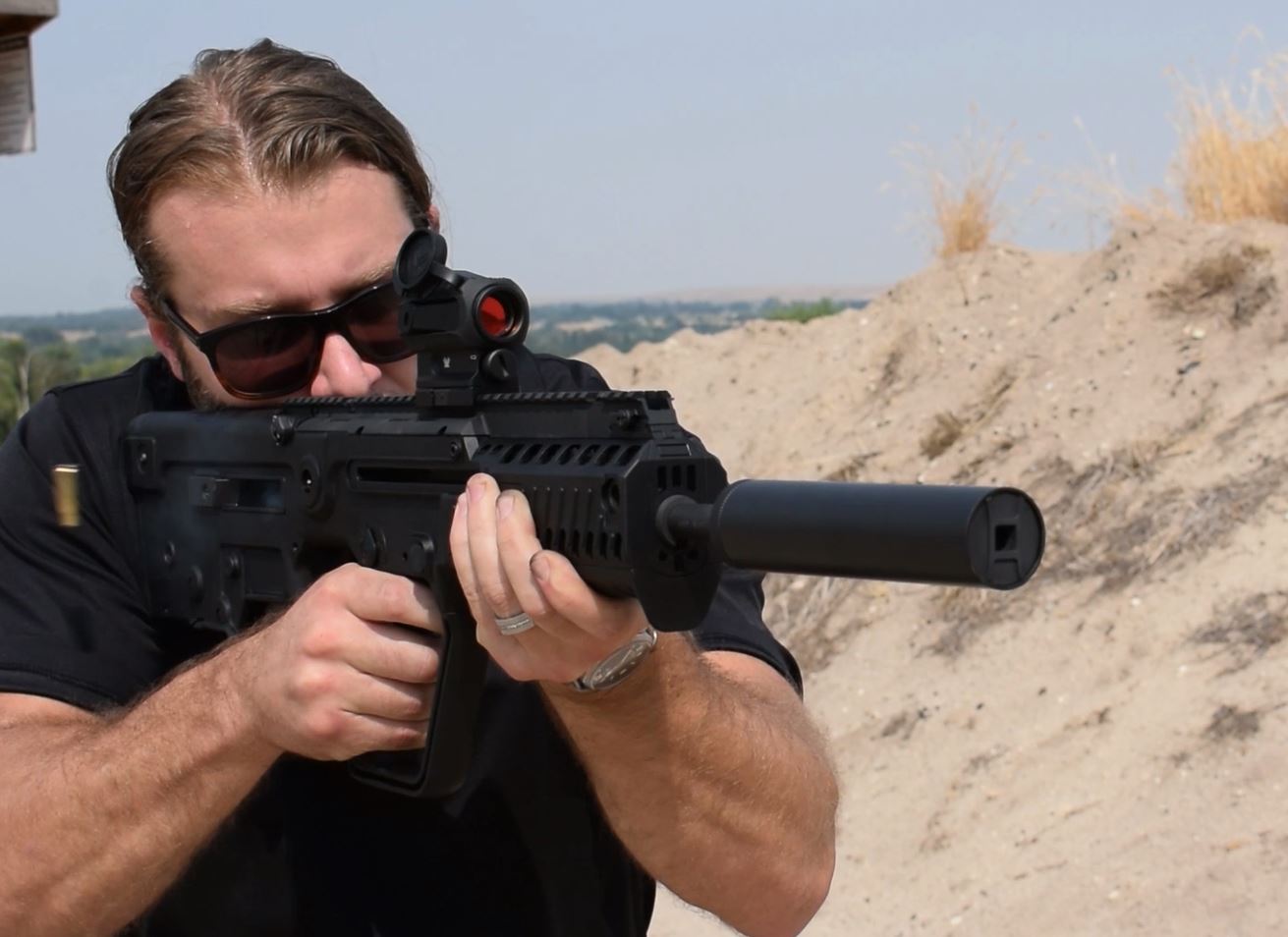The 300BLK (7.62×35) gives you options not found in any other factory cartridge for the AR-15/M4 platform. The cartridge was developed to provide improved performance from the AR platform with only a barrel change, using standard bolts, and gas impingement systems. Standard 5.56 NATO magazines can also be used with the 300BLK, though I recommend a magazine specifically designed for the cartridge, such as the outstanding Magpul® PMAG® 30 AR 300 B GEN 3TM .300BLK for optimal performance with all cartridges.
The design parameters of the 300BLK make an the ideal round for shorter barrels and for suppressed applications. Supersonic loads provide ballistic performance approximating that of the 7.62×39, while subsonic loads vastly outperform the 9×19 NATOr for suppressed applications.
Although the 300BLK hasn’t been officially adopted by any military, it’s in use by a number of special operations forces around the globe, including the US, UK and Netherlands.
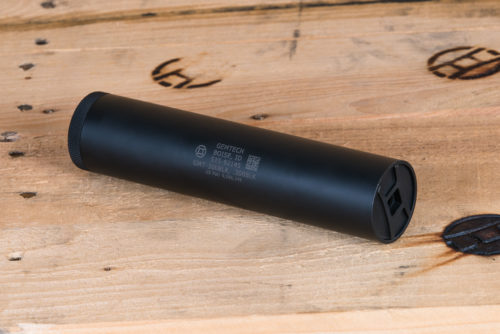
Gemtech GMT-300BLK
Gemini Technologies (Gemtech) is no newcomer to sound suppressor design. Headquartered in Meridian, Idaho, the company was founded in 1993 and manufactures sound suppressors for rifles, pistols, submachine guns (SMGs) and personal defense weapons (PDWs), as well as accessories and ammunition. The company is a founding member of the American Suppressor Association (ASA). Gemtech Gemtech is an International Organization for Standardization (ISO) 9001:2008 certified company..
The Gemtech GMT-300BLK is a 300BLK specific sound suppressor that’s full auto rated. Its rated for supersonic and subsonic ammo in down to a 7.5-inch (17.02 cm) barrel. It’s a direct thread-on suppressor, with a 5/8-24 thread. It’s a two-piece design and features Gemtech’s patented G-Core® mono-core technology. Sound reduction is 28-30dB, which is very good for a compact suppressor like the GMT-300BLK.
The suppressor features the Gemtech logo on the front, with a 3/8-inch socket so you can easily torque it down. Another cool thing about the design is that it also makes cleaning a snap. It’s completely user serviceable. You can easily remove the tube to clean the core.
When installing the GMT-300BLK, Gemtech recommends tightening the core to the barrel and then hand tightening the tube to the core.
Designed for short-barreled rifles (SBRs), the compact GMT-300BLK features all titanium construction to keep the weight down. It measures 7.5 inches (17.02 cm) long, 1.5 inches (3.81 cm) in diameter and weighs 14 ounces (396.89 g). It has a black Cerakote® finish with a reduced IR signature. Cerakote is a thin ceramic finish that is withstands high temperatures and is very durable.
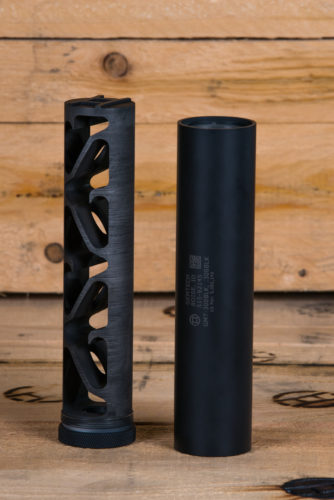
Gemtech provided me with a GMT-300BLK, on loan for evaluation as well as its American-made Gemtech 187GR Polymer Tip Subsonic 300BLK ammo. It’s outstanding ammo for suppressed applications. The polymer tip increases the ballistic coefficient of the ammo, as well as greatly enhancing terminal performance by initiating dramatic expansion upon impact. The suppressor was transferred to C2 Tactical in Tempe, Arizona,
The Nature of Sound
Sound is the sensation that’s experienced when the brain interprets vibration within the structure of the ear caused by rapid variations in the air pressure. Sound is commonly measured in decibels (dB).
The specification of the intensity of the sound, as ordinarily used, implies a comparison with the smallest level of sound detectable by the human ear. The smallest level of sound that can be detected by the human ear is around one dB (0.1 bel). Normal conversation is around 60 dB. The average threshold of pain for the human ear is around 130 dB.
According to OSHA, the threshold for a hearing safe impulse noise is 140 dB. Without hearing protection, exposure to any impulse noise over 140dB causes varying degrees of permanent noise-induced hearing loss. It can also lead to tinnitus. Most well-engineered suppressors take the dB level of their host firearm below 140 dB, making those suppressors effective primary-hearing safety devices.
There are two types of noise that can damage hearing: 1) short-duration, high-intensity noise, such as gunshots, and 2) prolonged exposure to lower levels of noise. Although individual sensitivity varies, many authorities believe that prolonged exposure to noise above 85 dB can lead to hearing damage.
How Sound Suppressors Work
There are three possible sources of sound from the discharge of a firearm that need to be considered when silencing a firearm: the weapon’s report, i.e., muzzle blast; the ‘crack’ caused by a supersonic bullet passing the sound barrier; and the sound from the cycling of the firearm’s action.
The muzzle blast is the most significant source of sound that’s generated by a firearm. A .22 LR handgun generates around 148 dB. A 9×19 NATO MP5 SMG generates around 157 dB. A M16 generates around 168 dB.
Muzzle blast is the consequence of the shock waves resulting from high-pressure gases exiting the barrel. If the pressure is reduced immediately before it exits, the weapon’s report will be reduced. Muzzle blast is also reduced by decreasing velocity of the gases and either absorbing the sound waves or canceling them by interference with reflected waves coming from the same source.
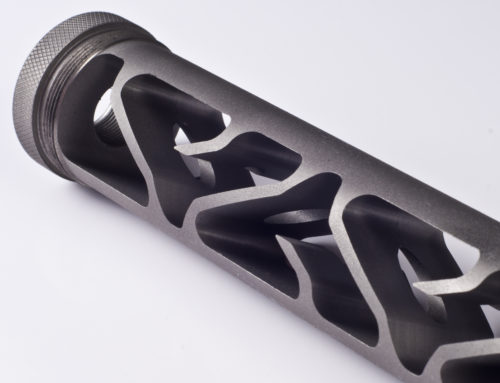
Sound waves behave in many ways similar to light waves. As with light waves, sound waves can be reflected, refracted, diffracted and scattered. Various combinations of components, such as baffles, spacers, packing material, mesh, expansion chambers, spiral diffusers, pressure relief ports, and wipes may be employed in a suppressor to ‘silence’ a firearm.
The GMT-300BLK employs a patented one-piece baffle system that is highly effective and provides improved gas flow dynamics that largely eliminates the first round pop common with traditional designs. With traditional suppressors, the first round is often louder than subsequent rounds and there may be a slight flash.
As a suppressor accumulates fouling during firing, its effectiveness will deteriorate. The maintenance requirements will differ depending on the suppressor. Some baffled systems are largely self-cleaning or require nothing more than dunking in solvent to clean out the fouling. Other designs may require repacking or the replacement of ‘wipes’ at the factory. It should be noted that silencer parts fall under provisions of the NFA. As has been mentioned the two-piece design and G-Core mono-core technology greatly simplify any cleaning of the GMT-300BLK suppressor.
Weapons with ported barrels and integral sound suppressors do not require the use of subsonic ammunition for effective sound reduction. They’re designed for specialized applications that require fully realized sound and flash suppression. Because the suppressor is integral to the weapon, the weapon may not be used in a non-suppressed mode.
Muzzle sound suppressors, such as the GMT-300BLK, are more versatile than integral suppressors, in that they can easily be removed when sound suppression is not necessary. If subsonic ammunition is employed, muzzle suppressors are often every bit as quiet as an integral suppressor. Because they do not reduce the velocity of a bullet, higher terminal velocities are possible for applications in which a sonic crack is not an important tactical consideration.

Selecting a Sound Suppressor
When selecting a sound suppressor/weapon system, a variety of factors need to be taken into consideration. These include the operational requirements in the mission in which it will be employed, any special ammunition requirements, cost, maintenance and any required modification to the weapon. Other considerations include POI shift between suppressed and unsuppressed, construction, back-pressure and thread-on vs. quick-attachment system.
Any comparisons between suppressors need to be carefully considered, since the method of testing that’s utilized by manufacturers may vary from manufacturer to manufacturer, making comparisons difficult, unless one has the details as to how the testing was conducted. US military requirements for testing are specified in MIL-STD-1474C. Has the suppressor been tested and if so, how? Gemtech tests all its suppressors to MIL-STD-1474C.
When you put on or take off a suppressor, you typically see some point-of-impact (POI ) shift. There are two types POI shift when mounting a suppressor and POI shift from shot to shot. POI shift when mounting a suppressor is more impacted by the threads on the weapon than the suppressor. POI shift is not as much of an issue if it is repeatable as the shooter can easily correct for the shift. POI shift from shot to shot is most often related to the mounting system of a quick attach suppressor. POI shift with the GMT-300BLK is very minimal and is repeatable.
Backpressure from the suppressor also needs to be considered. Suppressing a weapon can significantly increase backpressure. Excessive backpack pressure will increase the cyclic rate, causing weapon malfunctions, reduce the service life of the weapon, spit gasses back into the face of the operator, and cause increased fouling.
The backpressure created by traditional suppressors can be significantly reduced degree by suppressors, such as the GMT-300BLK, which are designed to control the gasses rather than simply trap them. There is still backpressure with the GMT-300BLK, but it’s much less noticeable.
Suppressor Mounting
As mentioned, the GMT-300BLK is a thread-mount suppressor. Threading on a suppressor is the strongest, most precise method of mounting a suppressor. They are generally more accurate and less prone to alignment issues and baffle strikes, although thread-mount suppressors can work themselves loose and out of alignment. Many users use Blue Locktite® on the threads, although its not necessary. Thread-mount suppressors are widely used on precision rifles.
A quick-attach suppressor does have advantages over a threaded suppressor for certain applications. Quick-attach suppressors allow the end user to more easily switch the suppressor between different weapon platforms, although they generally require the use of proprietary mounts. Gemtech offer a variety of quick-attach suppressors, in addition to thread mounted.
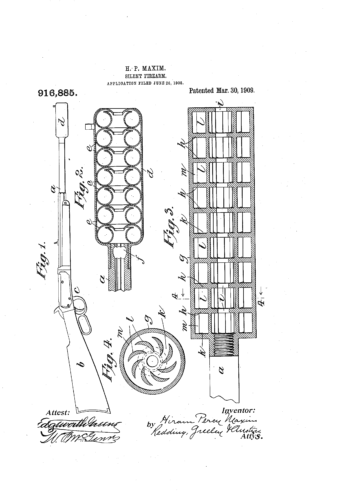
Construction
A variety of materials may be employed in the construction of a suppressor. Each has its pros and cons. Suppressor baffles are under extreme stress and the materials that are utilized must be matched to the application.
Stainless steel is a common material utilized in suppressor applications. It is durable, corrosion resistant, and handles heat well. It is also relatively low cost. A disadvantage is weight.
Gemtech opted for titanium for the GMT-300BLK. Titanium is lightweight and durable. The two most useful properties of titanium are corrosion resistance and strength-to-density ratio, which are the highest the highest of any metallic element. It’s often used where light weight and precision are important, such as in 7.62mm and larger bore applications.
The downside to titanium is that it cannot handle the heat generated by high volumes of fire as well as suppressors utilizing higher-temperature alloys such as INCONEL®. For the applications for which the 300BLK is designed, titanium is an ideal choice.
Conclusions
To sum it all up, the Gemtech GMT-300 is an outstanding suppressor, ideal for short-barrelled 300BLK applications. Its exceptionally well-designed and well-made, and offers superior performance. It has a MSRP of $995.95. Gemtech doesn’t have a written warranty but stands by their products.
Specifications
Gemtech GMT-300-BLK Sound Suppressor
Model: GMT-300BLK
Manufacturer: Gemini Technologies (Gemtech)
Caliber: .30 Caliber (300BLK)
Sound Reduction: 28-30dB
Diameter: 1.5 in. (3.81 cm)
Length: 6.7 in. (17.02 cm)
Weight: 14 oz.(396.89 g)
Mount: 5/8-24 thread
Material: Titanium
Full Auto Rated: Yes
Finish: Black Cerakote with Reduced Visual IR Signature
Country of Origin: USA
Warranty: No written warranty
MSRP: $995.95
Material Disclosure
I received this product on loan as a courtesy from the manufacturer so I could test it and give my honest feedback. I am not bound by any written, verbal or implied contract to give this product a good review. All opinions are my own and are based off my personal experience with the product.
*The views and opinions expressed on this website are solely those of the original authors and contributors. These views and opinions do not necessarily represent those of Spotter Up Magazine, the administrative staff, and/or any/all contributors to this site.
Photos courtesy Gemtech unless otherwise noted.

